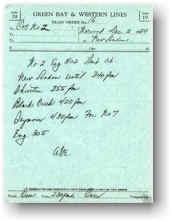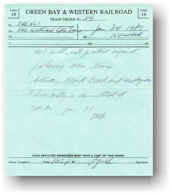|
Home
|
Dispatching forms were used to relocate the meeting spot for trains and alter the rules of the Timetable.
Here are details about train orders from Bob Welke.
Index |
|
||
Introduction |
For over one hundred years, the Green Bay & Western relied on Timetable operations to control the movement of trains. Train orders were special dispatching forms used to modify the timetable to suit special circumstances. Since the Green Bay Route was railroad whose train movements depended heavily on the timing of car ferry arrival and departures at Kewaunee and train orders were often issued to meet fit the circumstances. There were very specific rules on how to issue and handle Train orders and any violation of these rules could cause an accident. Train orders were either Form 19 or Form 31. They were made on very thin 7" x 9 1/2" onion skin paper - hence the nickname "flimsy" - since this allowed the station operator to make multiple copies at one time. Every time a train order was re-written it had to be read back to the Dispatcher to insure they were identical |
||
Form 19 |
A Form 19 was a special order from the Dispatcher to the Engineer and Conductor of a train which either gives them the authority to operate or modifies the timetable schedule. The orders were transmitted from the Dispatcher to a Station Agent, and then passed to the crew of a moving train via a train order hoop. The GB&W had their own rulebook into the 1970's which was nearly identical to the industry-standard "Consolidated Code of Operating Rules" (later referred to as the General Code of Operating Rules). They aren't listed as adopting the General Code until the third edition of the GCOR, which was effective on April 10, 1994 -- eight months after the GB&W was gone. (Better late than never?) |
||
Form 31 |
A Form 31 required the train to be stopped and the Conductor and/or Engineer pick up a Form 31 order, read it to the Station Operator to check for correctness, and then sign the order. The Station Operator then sent confirmation of the signatures back to the Dispatcher who issued a "complete" time and had the Superintendent initial the order back to the Station Operator. But it's not over yet! The operator then had to repeat the same order back to the dispatcher, including the operator's full last name. A copy was then given to all persons addressed -- except when order was signed only by the Conductor, but even then he had to deliver a copy to the engineer who repeated it back to the Conductor before proceeding. Rule 201 of the Consolidated Code of Operating Rules stipulated that "Train orders once in effect continue so until fulfilled, superseded or annulled." Therefore, once a Form 31 was issued time had little effect on it unless a expiration time was included on the Order. |
||
The End of Train Orders |
In the final edition of the Consolidated Code of Operating Rules (effective October 1, 1980) the rules still required Dispatchers to issue Train orders to Operators and to give them to train crews. Under the First Edition General Code of Operating Rules (effective April 27, 1986) a new rule 209(B) was added to allow mechanical transmission of Train Orders to outlying points where no Station Operator was on duty. The rules for movement by Train orders (Rules 200 to 224, S-225 and Forms S-A and B to Z) were no longer included when the Second Edition of the General Code of Operating Rules took effect on October 29, 1989. That effectively eliminated this form of operation by most all railroads. The last GBW Timetable (No.94, effective February 1, 1987) and Special Instructions (No.3, also effective February 1, 1987) still indicate train order operation at that time. The only open depots at that time were Wisconsin Rapids, (Sunday, 5 am to 2 pm, Mon-Thurs 5 am to Midnight, Friday 8 am to midnight and Saturday 8 am to 5 pm) Plover, Monday to Saturday 8:30 am to 5:30 pm, Broadway tower, continuous and the Norwood Dispatchers, continuous except 12:01 am to 8:01 am Sunday) |
||
Track Warrant Control |
Track Warrants were introduced with the issuance of the First Edition
of the General Code of Operating Rules, effective April 27, 1986. A Track Warrant
(GCOR Rules 400 to 413) is a preprinted single page
form that contained boxes to check and blanks to fill in. The Dispatcher
could transmit them via fax or could dictate over radio or phone lines
telling crews which lines to check and what to put in the blank spaces
on just those lines.
Until mid-1990, the GB&W still used train orders to dispatch the railroad, but then it switched to Track Warrant Control, which allows more contact between the Norwood dispatcher and trains out on the road. The GB&W dispatchers were moved on August 2, 1991, into the FRVR's ex-C&NW passenger depot in Green Bay. |
Train Orders from 1963: On October 17, 1963 a Form 19 was used to have the Amherst Junction station operator change the meeting spot for cross-state trains Nos. 1 and 2 from New London to Scandinavia, which was 22 miles further west. Engines #309 and #310 led the fast freights that day, a sign of the ascendancy of the Alco Century locomotives to the forefront of the railroad's power.
A 1954 Train Order: Eastbound Train No. 2 (led by FA-1 #502) was ordered to wait at New London, Shiocton, Black Creek, and finally Seymour for Train No. 7 and RS-3 #305 on the afternoon of December 2, 1954.
A pair of Form 19 "flimsies" from 1962: One of the Train Orders has engine #309 leading westbound Train No. 1 meet #310 and Train No. 2 at Oneida. The westbound train had to take the siding at the meet.


